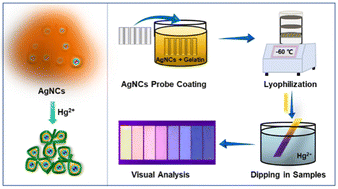A fluorimetric test strip with suppressed “Coffee Ring Effect” for selective mercury ion analysis†
Abstract
Nowadays, test strips are widely applied, but their use is mostly limited to the qualitative or half-quantitative analysis of targets. The main reason for their limited use is the “Coffee Ring Effect” (CRE) of probe materials, which leads to a heterogeneous probe distribution and poor testing reproducibility and sensitivity. In the present work, a fluorescent test strip was fabricated with a suppressed CRE of silver nanocluster (AgNC) probes coated by gelatin (Gel) under vacuum-aided fast lyophilization. Uniform and stable deposition of AgNC probes was achieved onto the test strips with a high loading capacity. The AgNCs displayed specific responses to Hg2+ ions, allowing sensitive and quantitative analysis in the linear concentration ranges from 0.20 to 50000 nM with a limit of detection of 0.10 nM. Given the advantages of rapid and facile preparation, CRE suppression, high biocompatibility, and cost-effectiveness, such a fabrication protocol may pave the way for the design of various test strips-based devices for point-of-care analytical applications in the fields of environmental monitoring, food quality analysis, and clinical diagnostics.



 Please wait while we load your content...
Please wait while we load your content...